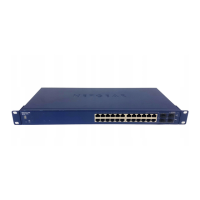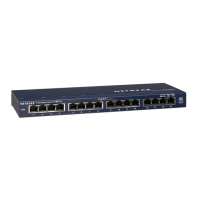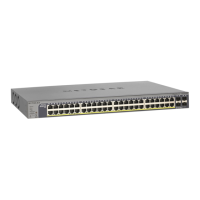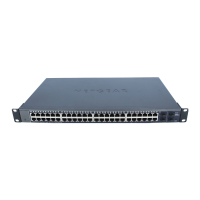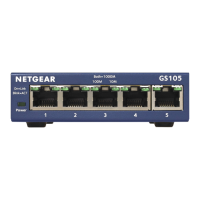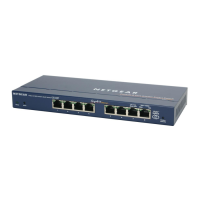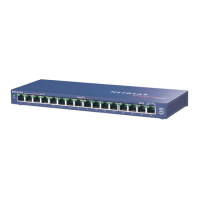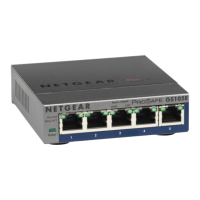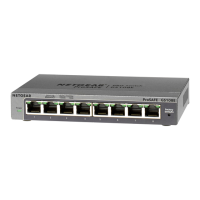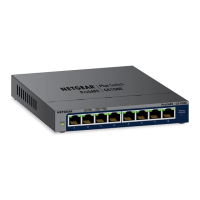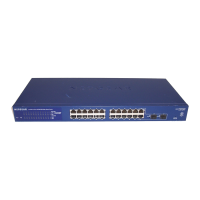
Do you have a question about the NETGEAR GS724Tv3 - ProSafe Gigabit Managed Switch and is the answer not in the manual?
Defines the intended audience for this guide, including system administrators and support providers.
Outlines the structure of the manual, listing chapters and their respective page numbers.
Explains the typographical conventions, formats, and scope of information presented in the manual.
Details the version history of the manual, including part number, version, date, and description.
Provides instructions on connecting the switch to a network for remote management.
Introduces the NETGEAR SmartWizard Discovery utility for initial switch configuration.
Details steps for setting up a switch in a network with a DHCP server using SmartWizard.
Explains how to assign a static IP address to the switch if no DHCP service is available.
Describes the available management interfaces for the switch: Web user interface and SNMP.
Guides users on how to access and log in to the switch's Web interface.
Provides instructions on how to change the login password for the switch.
Explains the procedure for upgrading the switch's application software.
Describes how to configure and view general device information like system name and contact.
Details how to configure IP information (IP address, subnet mask, gateway) for the switch.
Explains how to configure the switch's time using SNTP or local settings.
Guides on configuring authentication and encryption settings for SNMPv3 user profiles.
Explains how to specify LLDP parameters applied to the switch for network discovery.
Details how to configure physical interfaces, including speed, duplex, and Green Ethernet.
Explains Link Aggregation Groups (LAGs) to combine multiple links for fault tolerance.
Provides information on Virtual LANs (VLANs) and their benefits for network segmentation.
Describes Spanning Tree Protocol (STP) versions (STP, RSTP, MSTP) to prevent network loops.
Explains IGMP Snooping for intelligent forwarding of multicast traffic.
Details how to search the MAC address table for unicast entry information.
Covers Class of Service (CoS) queueing, mapping packets to appropriate egress queues.
Defines switch egress queues, controlling bandwidth, queue depth, and transmission scheduling.
Specifies how internal traffic classes map to corresponding DSCP values.
Configures login password, RADIUS, TACACS+, and authentication lists for security.
Details RADIUS server settings for centralized authentication for web access and 802.1X.
Explains TACACS+ for centralized user management and network security.
Covers 802.1X and port-based network access control for device and user authentication.
Enables or disables port access control on the system using 802.1X authentication.
Allows configuration of MAC filters, storm control, and port security settings.
Creates MAC filters to limit traffic allowed into and out of specified ports.
Configures settings to discard packets when rates exceed defined values to prevent network overload.
Enables or disables port security features to lock ports and control MAC addresses.
Ensures authorized access by blocking unwarranted network access attempts.
Defines MAC Access Control Lists (ACLs) with rules for matching Ethernet frames.
Allows network managers to define classification actions and rules for IP packets.
Defines rules for IP-based extended ACLs, specifying traffic forwarding or discarding.
Provides information on the number and type of traffic transmitted and received by the switch.
Displays a summary of per-port traffic statistics, including received and transmitted packets.
Covers system messages for events, faults, and errors, stored locally or forwarded.
Allows viewing and configuring port mirroring for network traffic analysis.
Provides options for rebooting the switch and resetting configurations to factory defaults.
Explains how to upload configuration and image files from the switch to a TFTP server.
Details system file downloads to the switch using TFTP or HTTP.
Manages system software versions, including dual image configuration and viewing status.
Includes utilities like Ping and TraceRoute to diagnose network connectivity issues.
Allows sending Ping requests to specified IP addresses to check network host communication.
Lists hardware specifications such as interfaces, memory, and supported standards.
Details features and default settings for port characteristics and quality of service.
Explains VLANs and their advantages for network segmentation and management.
Provides an example of creating a MAC-based ACL to permit specific Ethernet traffic.
Demonstrates configuring 802.1X-based authentication for ports using a RADIUS server.
Shows how to create an MSTP instance for efficient VLAN traffic channeling.
Index entries starting with the letter A.
Index entries starting with the letter C.
Index entries starting with the letter D.
Index entries starting with the letter E.
Index entries starting with the letter F.
Index entries starting with the letter G.
Index entries starting with the letter H.
Index entries starting with the letter I.
Index entries starting with the letter L.
Index entries starting with the letter M.
Index entries starting with the letter N.
Index entries starting with the letter P.
Index entries starting with the letter Q.
Index entries starting with the letter R.
Index entries starting with the letter S.
Index entries starting with the letter T.
Index entries starting with the letter U.
Index entries starting with the letter V.
Index entries starting with the letter W.
